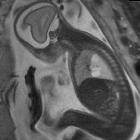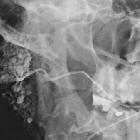cystic lung disease































Cystic lung disease is an umbrella term used to group the conditions coursing with multiple lung cysts.
Clinical presentation
The clinical presentation is an important clue to the differential diagnosis of cystic lung diseases .
Diseases that present with insidious dyspnea or spontaneous pneumothorax:
- lymphangioleiomyomatosis
- Birt-Hogg-Dubé syndrome
- pulmonary Langerhans cell histiocytosis
- desquamative interstitial pneumonia
- lymphocytic interstitial pneumonitis
Congenital cystic lung diseases that present with recurrent pneumonia or are asymptomatic:
Diseases that present with signs/symptoms of infection:
Multisystemic diseases that primarily present with extrapulmonary signs/symptoms:
- neurofibromatosis type 1
- amyloidosis
- light chain deposition disease
- lymphangioleiomyomatosis associated with tuberous sclerosis
Pathology
A lung cyst is a gas-filled structure with a thin perceptible wall, typically <2 mm in thickness but can be up to 4 mm. The diameter of a lung cyst is usually <1 cm. By conventional definition in the literature, a lung cyst can be distinguished from a cavity for which the wall thickness is greater than 4 mm. However, in practice, clear separation of the two entities can sometimes be difficult .
Etiology
Primary pulmonary disease where diffuse cysts are the predominant feature:
- pulmonary Langerhans cell histiocytosis
- lymphocytic interstitial pneumonitis
- lymphangioleiomyomatosis with or without tuberous sclerosis
- tracheobronchial papillomatosis
- desquamative interstitial pneumonia
- Sjogren syndrome
- neurofibromatosis type 1
- Birt-Hogg-Dubé syndrome (rare)
- pulmonary mesenchymal cystic hamartoma (rare)
Acquired cystic lung disease or cysts as a secondary feature of a primary disease:
- honeycombing in usual interstitial pneumonia pattern
- pulmonary laceration in trauma
- pneumocystis pneumonia
- sarcoidosis
- light chain deposition disease
- amyloidosis
Radiographic appearance
CT
The approach to cystic lung disease centers around the appearance on high resolution CT and history .
Once the lucencies are found to be true cysts (thin walled), the location should be determined. Subpleural or intrapleural cysts include:
- bullae/blebs, including in paraseptal emphysema: upper lobe predominance
- honeycombing due to pulmonary fibrosis: lower lobe predominance, stacked (multiple rows)
In contrast, intraparenchymal cysts are surrounded by lung parenchyma and can be further evaluated by their associated features:
Intraparenchymal cysts with associated ground glass opacities:
- pneumocystis pneumonia: diffuse ground glass opacities with few cysts, septal thickening, in patients with immunodeficiency (e.g. HIV/AIDS)
- desquamative interstitial pneumonia: lower lung predominant ground glass opacities with few cysts, in smokers
- lymphocytic interstitial pneumonitis: lower lung predominant perilymphatic cysts, interlobular septal thickening, few centrilobular nodules, possible ground glass opacities, in patients with autoimmune disease (e.g. Sjögren syndrome) or immunodeficiency (e.g. HIV/AIDS)
Intraparenchymal cysts with associated pulmonary nodules:
- pulmonary Langerhans cell histiocytosis: upper lung predominant, bizarre shaped cysts with variable wall thickness, stellate nodules, in young smokers
- lymphocytic interstitial pneumonitis: as above
- light chain deposition disease: diffuse cysts, diffuse irregular nodules, lymphadenopathy, in patients with plasma cell dyscrasias
- amyloidosis: peribronchovascular or subpleural cysts, often calcified nodules, in patients with Sjögren syndrome (with or without lymphocytic interstitial pneumonitis)
Most other causes of intraparenchymal cysts do not have associated findings and may be instead distinguished by their distribution:
Unifocal pulmonary cysts:
- incidental pulmonary cyst
- pneumatocele: usually transient, related to recent pneumonia or trauma
- hydatid disease (echinococcosis)
- bronchogenic cyst
- congenital pulmonary airway malformation
- pulmonary sequestration (intralobar)
Multifocal pulmonary cysts :
- lymphangioleiomyomatosis: diffuse, uniformly round cysts, with spontaneous pneumothorax or chylothorax, in young women or patients with tuberous sclerosis
- Birt-Hogg-Dubé syndrome: lower lobe predominant, disproportionately paramediastinal, elongated (floppy) cysts, with spontaneous pneumothorax and skin lesions or renal cancer
- lymphocytic interstitial pneumonitis: as above
- neurofibromatosis type 1: upper lobe predominant
- tracheobronchial papillomatosis
- cystic lung metastases
Differential diagnosis
If the pulmonary lucencies in question are not true cysts (not thin walled airspaces), there are several considerations other than cystic lung disease:
- cystic bronchiectasis: connected to tubular airways
- centrilobular emphysema: without distinct walls
- cavitating lung lesions: wall thickness >4 mm
Siehe auch:
- Bronchiektasen
- Langerhanszell-Histiozytose der Lunge
- Pneumatozele
- Sarkoidose
- Tuberöse Sklerose
- Neurofibromatose Typ 1
- Lymphangioleiomyomatose
- Honigwabenmuster
- kongenitale pulmonale Atemwegsmalformation (CPAM)
- Kavernöse Lungenläsionen
- Lungenzysten
- Lungenmetastasen
- Emphysembullae
- Sjögren-Syndrom
- lymphozytisch interstitielle Pneumonie
- cystic bronchiectasis
- Pneumocystis jiroveci Pneumonie
- gewöhnliche interstitielle Pneumonie (UIP)
- Neurofibromatose
- tracheobronchiale Papillomatose
- Emphysem
- zystische Lungenläsionen bei Kindern
- Birt-Hogg-Dubé-Syndrom
- Lungenlazeration
- multiple Lungenherde
und weiter:

 Assoziationen und Differentialdiagnosen zu multiple zystische Lungenherde:
Assoziationen und Differentialdiagnosen zu multiple zystische Lungenherde:



















